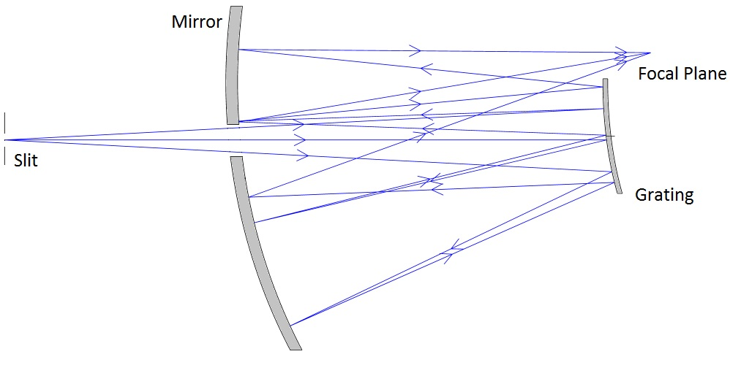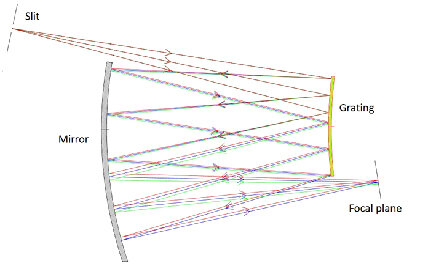Imaging Spectrometer with Reflective Grating
| 682 - Abstract: |
| Imaging spectrometers are important optical instrument, which are used among others in space missions for Earth Observation and Science. Many imaging spectrometer instruments are based on mirror designs with reflective gratings and most of these designs can achieve only unit magnification or magnification ratios very close to one. Using the state-of-the-art to achieve different magnification values alters the configuration symmetry and leads to strong aberrations and, therefore, poor image quality. The following invention allows reaching magnification values different from one, while enabling compact and cost effective designs with a high performance. License agreements are sought. |
Description:
The invention proposed by the European Space Agency concerns the design of an imaging spectrometer based on reflective grating capable to achieve a magnification value different from one. The design is very flexible and there are several embodiments of the invention that can be selected depending on the requirements and the applications.
For some applications, the possibility to use a spectrometer with a magnification different from one is a key factor, i.e. fusion of panchromatic and spectral images and design of more compact instruments. For the fusion of panchromatic and spectral images a magnification lower than one is advantageous. A magnification larger than one is useful for compact designs.
The invention has several embodiments and can, for example, be implemented with a conventional grating and a mirror only. One solution with central obstruction is shown in Figure 1. The system comprises a conic shaped mirror and a conic shaped reflective grating. A special feature of this design is the double diffraction from the grating. Multiple reflections in the imaging spectrometer allow a compact design, while having a good image quality. The beam footprints are well separated on the optical components.
Other embodiments of the invention are attained by combining rotation and displacement of the mirror-grating system. Moreover, the grating and the mirror can have different geometrics and are ideal for freeform optimization. For instance, the imaging spectrometer can comprise a conic mirror in combination with a parabolic grating. Figure 2 shows the combination of a spherical grating with a free form mirror.
The aforementioned designs are characterized by double diffraction from the grating. The invention can also be used with a grating working in single diffraction. This design allows a higher throughput in comparison to the other solutions, which might be relevant for some applications.
Other designs might also be implemented, for instance, a solution with spherical grating and three different aspherical mirrors or a solution with an aspherical mirror and a multi blazed grating.
Innovations and advantages:
The flexibility to set up the proposed imaging spectrometer and the possibility to use a different magnification value for the spectrometer can lead to a more compact and cheaper optical design, i.e. simplified telescope design.
A minimized number of optical elements and multiple reflections on the same optical element lead to a reduction of the overall size of the spectrometer and can therefore save costs and mass.
A fully reflective solution allows a large spectral range of the system. Moreover, the use of conventional grating instead of freeform grating leads to lower costs and an eased manufacturing. The grating can be used both for single or double pass, depending on the implementation.
Altogether, the invention gives a cost effective solution for an imaging spectrometer.
Domain of application:
Imaging spectrometer have a broad range of terrestrial applications. For example:
- Control of food quality
- Control of industrial processes
- Environmental monitoring
- Materials identification
- Energy applications (e.g. biofuels analysis and control of photovoltaic panels)
- Medical applications
- Forensic science
- Commercial space applications
- Remote sensing (Space, UAV, drones etc)








